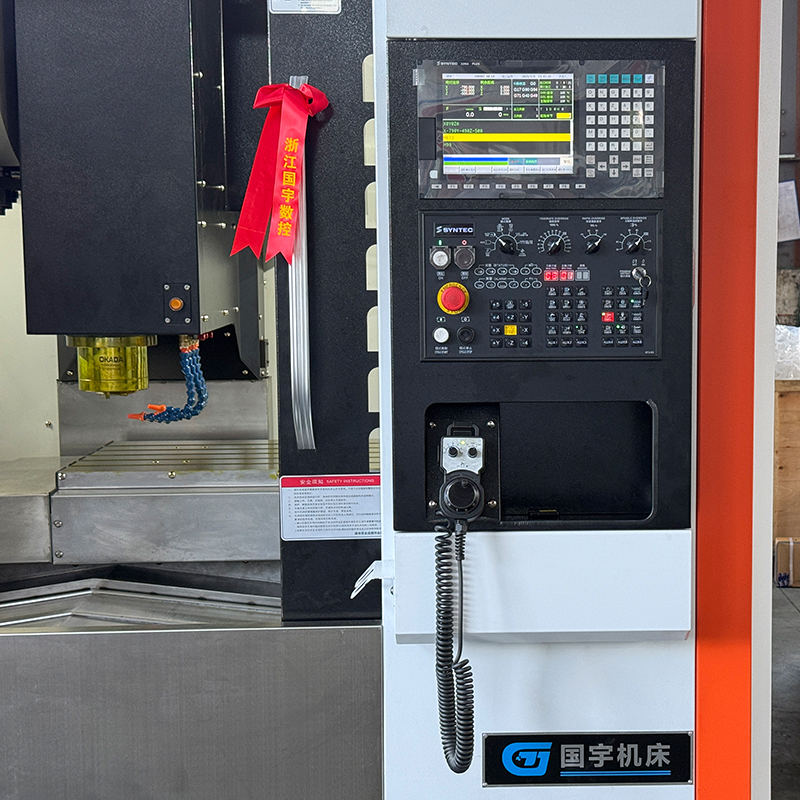Technical Characteristics: The machine tool is a single-column vertical guideway structure. The colu...
See Details
The Slant-bed CNC Lathe is an advanced type of precision machining equipment widely used in industries such as aerospace, automotive, electronics, and tool manufacturing. Unlike traditional flat-bed lathes, this machine features a slanted bed design that provides rigidity, stability, and chip removal efficiency. The slanted structure enhances cutting accuracy, reduces vibration, and ensures consistent performance during long machining operations. To better understand its functions and construction, the main components of a Slant-bed CNC Lathe can be discussed in several key aspects, each playing a vital role in its overall operation.

The defining component of the Slant-bed CNC Lathe is its bed, which serves as the foundation for all other parts. The bed is designed with a slanted or inclined angle—typically between 30° to 45°—which allows cutting chips and coolant to fall away naturally during machining. This improves visibility, cleanliness, and machining efficiency.
Constructed from high-strength cast iron or alloy steel, the bed provides exceptional rigidity to minimize deformation under heavy loads. The slant-bed structure also reduces the travel distance between the spindle and the turret, improving tool accessibility and enhancing precision. The Slant-bed CNC Lathe benefits greatly from this ergonomic layout, which supports stable cutting and easy maintenance while ensuring long-term durability and high machining accuracy.
The second major component of the Slant-bed CNC Lathe is the spindle system, which is the heart of the machine’s rotation mechanism. The spindle holds and rotates the workpiece at variable speeds, enabling the cutting tools to perform turning, threading, drilling, or boring operations with precision.
Most spindles in a Slant-bed CNC Lathe are powered by high-performance servo motors or variable-frequency drives, ensuring stable speed control and consistent torque output. Precision bearings are used to support the spindle, reducing vibration and maintaining smooth operation at high speeds. In some advanced models, the spindle is equipped with a built-in cooling system and an automatic lubrication device to prolong service life and maintain working conditions. The high rigidity of the spindle assembly ensures the machine can handle both rough and fine machining tasks efficiently.
The third essential component of a Slant-bed CNC Lathe is the turret and tool system. The turret is a rotating structure that holds multiple cutting tools and allows rapid tool changes during machining operations. With a slant-bed layout, the turret is positioned closer to the workpiece, reducing tool travel distance and increasing efficiency.
Modern Slant-bed CNC Lathes are equipped with either electric or hydraulic turrets capable of automatic indexing. This enables the machine to switch between different cutting tools quickly and accurately, minimizing downtime. Tool holders can accommodate turning, drilling, threading, and grooving tools, making the machine highly versatile. Additionally, the turret’s precise locking mechanism ensures that each tool is held firmly in position during machining, resulting in improved surface finish and dimensional accuracy.
The fourth key aspect of a Slant-bed CNC Lathe is the guideway and feed system. The guideways serve as the path along which the carriage and turret move. In slant-bed designs, linear guideways or box-type guideways are commonly used, each offering different performance advantages. Linear guideways allow smooth and rapid movement, while box guideways provide rigidity for heavy cutting.
The feed system is powered by precision ball screws and servo motors that control the movement of the cutting tools along the X and Z axes. This ensures accurate positioning and consistent feed rates. The Slant-bed CNC Lathe benefits from this advanced feed system by achieving high machining precision and smooth surface finishes, even when working with complex geometries or hard materials.
The fifth major component of the Slant-bed CNC Lathe is the computerized control system. This system functions as the brain of the machine, managing all motion commands and tool operations. It allows operators to input machining programs, control spindle speeds, set feed rates, and monitor real-time performance.
Modern control systems in a Slant-bed CNC Lathe often feature a user-friendly touch screen, digital display, and advanced programming capabilities such as G-code and conversational programming. They can store multiple machining programs and automatically execute them with precision. Additionally, some systems support remote monitoring, error diagnostics, and production data tracking. This integration of intelligent control technology ensures high productivity, consistent machining accuracy, and efficient workflow management.
The sixth important aspect of a Slant-bed CNC Lathe is its chip removal and cooling system. During machining, metal chips and heat are continuously generated. The slanted design naturally allows chips to slide down into a conveyor or collection bin, reducing manual cleaning requirements.
The cooling system sprays cutting fluid directly onto the cutting zone to lower temperatures, reduce tool wear, and maintain dimensional stability. The Slant-bed CNC Lathe typically includes a filtration unit that recycles and purifies the coolant for repeated use, contributing to energy efficiency and environmental protection. This system ensures smooth machining and extends the life of both the tools and the machine.
Our team of digital and business experts will guide you to the right direction.
Let's Talk